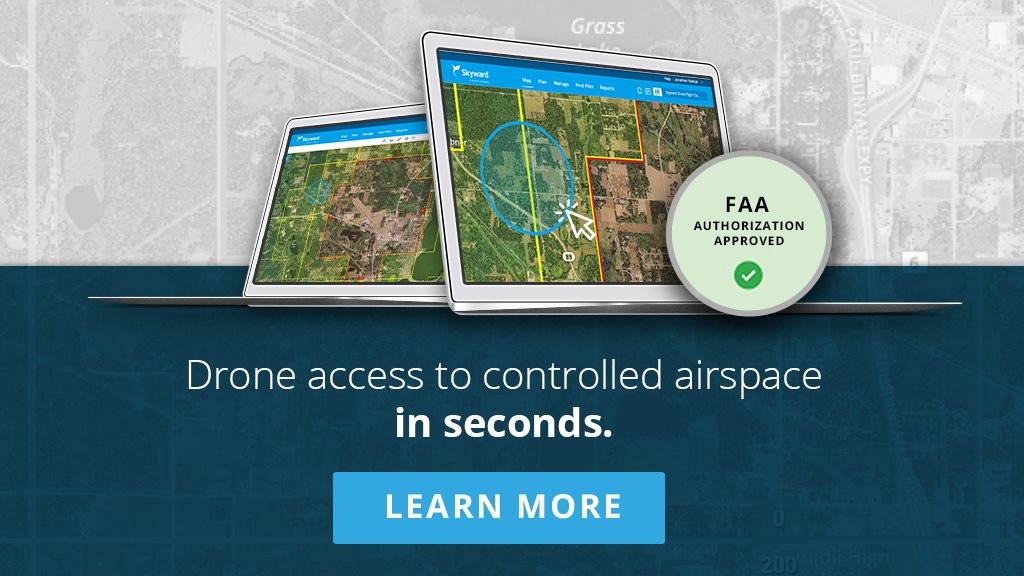On October 17th Skyward, a Verizon company, announced that it had been approved to provide commercial drone operators instant access to controlled airspace using the Low Altitude Authorization and Notification Capability or LAANC.
The approval process involved meetings over the course of a year helping to define the program, agreeing to a memorandum of understanding outlining the rules for the LAANC program, and demonstrating that the software Skyward built met those requirements.LAANC is a system developed by the FAA in partnership with a 12 company working group in order to improve safety on the potential integration of manned and unmanned aircraft in controlled airspace. Skyward is part of this group and it is the first to get their LAANC-supporting technology approved by the FAA. This certification will enable businesses to access airspace that previously required the submission of a manual request for authorization, and it will automate the approval process, reducing the wait time from months to seconds.The FAA has announced that the program will be rolled out this fall initially at Cincinnati International Airport (CVG), Reno (RNO), San Jose (SJC), Lincoln (LNK) and eventually expanded to over 40 airports across the nation by the end of the year and will be aggressively expanded in 2018.“This is a stepping stone for UAS traffic management, and the FAA has been visionary in deploying LAANC as a meaningful step forward,” said Skyward strategy director Matt Fanelli.In August 2016 the FAA implemented Part 107 which significantly lowered the barrier to entry for commercial operators, unfortunately the rule also created an operational hurdle for companies in urban areas, especially for early adopters who had previously coordinated directly with local air traffic control in a one-off manner.As a follow up to that important ruling In the Oct 11 Federal Register, the FAA stated that immediate implementation of LAANC is “vital to the safety of the National Airspace System because it would (1) encourage compliance with 14 CFR 107.41 by speeding up the time to process authorization requests (2) reduce distraction of controllers working in the Tower, and (3) increase public access and capacity of the system to grant authorizations.”"Based on customer feedback, we know most of their jobs are in controlled airspace and getting access to fly in these areas is one of their largest business pain points," said Mariah Scott, Co-President of Skyward. "Operators have had to wait 60-90 days to receive authorization under the existing system. Now, with Skyward and LAANC, enterprises can get approval to fly in just two clicks. With this hurdle gone, we can expect to see substantial adoption of drone technology at the enterprise level."Commercial drone pilots that apply for instant access to controlled airspace with LAANC must still abide by the rules of Part 107. Certain areas of controlled airspace are not accessible through LAANC and many have varying altitude limits (often lower than 400 feet).Implementation of LAANC will not have an effect of BVLOS flights and companies seeking to fly beyond visual line of site must still apply for a waiver from the FAA. LAANC will give instant access to some areas of controlled airspace but it will not waive other areas of Part 107. Once LAANC is fully implemented, the hope is that it will reduce the number of controlled airspace waiver requests significantly and allow the FAA to focus on waiver requests for BVLOS, night flights, flights over people, and others.LAANC is designed to increase the utility that commercial operators in particular and industry in general derive from the addition of drones to their existing workflows, but LAANC is just as much about safety as it is efficiency. To learn more about instant access to controlled airspace with Skyward, visit their site to register for a free webinar on November 9 at 1 p.m. ET.Subscribe
The information you submit will be stored and used to communicate with you about your interest in Commercial UAV News. To understand more about how we use and store information, please refer to our privacy policy.
October 24, 2017
Skyward to Provide Commercial Drone Operators Instant Access to Controlled Airspace through LAANC















Comments